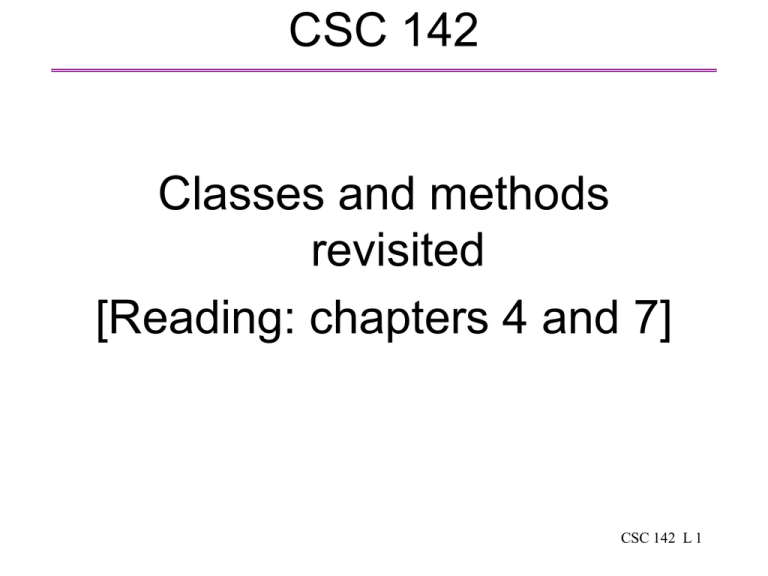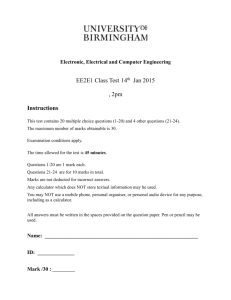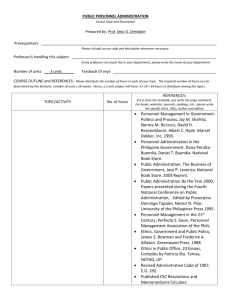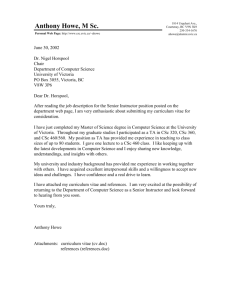Java class - Seattle Central College
advertisement

CSC 142
Classes and methods
revisited
[Reading: chapters 4 and 7]
CSC 142 L 1
Overloading: an example
Printing in a console window
System.out.print("Hello"); // a string
System.out.print(true); // a boolean
System.out.print('c'); // a character
System.out.print(3); // an integer
System.out.print(new Double(5.1));//an object
In the class PrintStream (class type of out),
there are several methods with the same
name, namely print.
They differ by their formal parameter list.
CSC 142 L 2
Method overloading
In a class, you can define multiple methods
with the same name.
The compiler picks the right method based on
the arguments passed to the method.
Advantage: give the illusion that one method
works on many types.
Compiler gives an error if there is more than
one possible match. If the match is not exact,
the compiler does some automatic conversion.
Complete matching algorithm rather complex
CSC 142 L 3
Example: multiple constructors
public class MyClass {
public MyClass(){/* default */}
public MyClass(int i){/* code */}
public MyClass(double x){/* code */}
public MyClass(String s, int i){/* code */}
}
// for a user of MyClass
MyClass c1=new MyClass();
MyClass c2=new MyClass(3);
MyClass c3=new MyClass(3.4);
MyClass c4=new MyClass("Hello",34);
MyClass c5=new MyClass(new Double(3.7));
//Double(3.7) is unboxed to the double 3.7
CSC 142 L 4
Another example (1)
Define an area method in a Calculator class.
pass to area an object (type Square,
Circle, Triangle…) and return its area.
These types are defined by some other
classes.
Calculator m = new Calculator();
//Default square,circle and rectangle
Square s = new Square();
Circle c = new Circle();
Triangle t = new Triangle();
// Areas of s,c and t
System.out.println("s: "+m.area(s));
System.out.println("c: "+m.area(c));
System.out.println("t: "+m.area(t));
CSC 142 L 5
Another example(2)
Write 3 versions of area in class Calculator
public double area(Square s)
{/* Return the area of Square s */}
public double area(Triangle t)
{/* Return the area of Triangle t */}
public double area(Circle c)
{/* Return the area of Circle c */}
See the full code on the class web site
Design issue:
Should the area functionality be in
Calculator, or in each of the classes
Square, Circle,…?
CSC 142 L 6
Ambiguity
public class SomeClass{
public void foo(double x,int i)
{/*version 1*/}
public void foo(int i,double x)
{/*version 2*/}
}
// for a user of SomeClass
SomeClass c = new SomeClass();
c.foo(4.5,3); // version 1
c.foo(5,4.5); // version 2
c.foo(1,2); // which one?
The compiler will tell you.
CSC 142 L 7
static method (1)
In a Calendar class, define a method to check
if a year is a leap year
public boolean isALeapYear(int year){
return ((year%4==0 && year%100!=0) ||
year%400==0);
}
By design, isALeapYear doesn't use any
instance of Calendar. It uses only the formal
parameter year.
Don't declare it as an instance method.
Declare it as a class method
public static boolean isALeapYear(int year)
To call the method, write e.g.
if (Calendar.isALeapYear(y))...
CSC 142 L 8
static method (2)
In a static method, only other static methods,
constants or variables of the class can be
used.
A non static member of a class is always
associated with an object (this). this is not
available in a static method since the method
can be called without an instance of the
class.
CSC 142 L 9
public static void main(String[] args)
All Java applications start by executing a special
method called main
In BlueJ, no need for it since BlueJ allows the
user to manipulate the objects interactively.
In other environments (e.g. JBuilder), write:
public class MyClass{
public static void main(String[] args){
MyClass c = new MyClass();
c.foo(); // some method in MyClass
}
}
CSC 142 L 10
What about String[] args?
When executing a java program,
arguments can be provided to the program
via the command line
Write 'java className parm1 parm2 …' (e.g.
in a DOS window).
parm1, parm2, … are stored in the String
array args
Example: Salutations.java (available as a
sample program).
interactive mode: enter the name using a
dialog box
command line mode: write 'java Salutations
Valerie'
CSC 142 L 11
Local variables: scope and lifetime
Local variables: variables defined within
methods (formal parameters are local variables)
Scope (where a variable can be used):
From the declaration line to the brace closing
the block where the declaration line is.
Lifetime (How long a variable is available)
A local variable is created when the control
flow is on its declaration line. It is destroyed
when leaving the block where the variable is
declared
CSC 142 L 12
Example
public void foo(int i)
//i is created and initialized with the actual
//parameter value every time foo is executed
{
// print the digits of i one by one
do{
int j; //created at every iteration
//of the loop
j=i%10;
System.out.println(j);
i/=10;
}while(i>0);//j is destroyed
// create and initialize s
String s="Thanks for using foo";
System.out.println(s);
CSC 142 L 13
}// s and i are destroyed
Object: scope and lifetime
An object can be used wherever a reference to
the object is available.
Visibility of the instance fields:
everywhere if declared public within the class
of the object
only within the class of the object if declared
private
Lifetime of an object
Created by the call to the class constructor
(using new)
Destroyed when all references to the object are
destroyed (the memory is reclaimed by the
garbage collector).
CSC 142 L 14
Example
public class Drawing{
//the window reference and a GWindow object are
//created whenever a Drawing is constructed
private GWindow window = new GWindow();
public Drawing()
{
Rectangle r = new Rectangle();
window.add(r);
}// r is deleted. What about the Rectangle it
// referred to? Can't tell. But may be kept
// if the GWindow object creates a reference
// to it in the add method.
}
// in some other method: the Drawing is kept
// as long there is a reference to access it.
Drawing d = new Drawing();
CSC 142 L 15
What about class fields?
Created when the class is loaded by the JVM
Destroyed when the application terminates
Visibility: same as for instance fields
public: everywhere
private: only within the class
public class MyClass{
// count available everywhere
// (as MyClass.count) as soon as MyClass
// is loaded by the JVM.
public static int count;
// more code…
}
CSC 142 L 16
Packages in Java (1)
A package is a named collection of classes. It
defines a namespace for the classes that it
contains.
For large projects, packages prevent name
collision.
e.g., if you create a JOptionPane class, the
compiler won't confuse it with the usual
JOptionPane class, which is actually the
javax.swing.JOptionPane class.
CSC 142 L 17
Packages in Java (2)
To create a package use the package keyword.
package org.seattlecentral;
// import statements
public class MyClass{/*code*/}
MyClass is actually org.seattlecentral.MyClass
On the computer, the java compiler creates the
bytecode file MyClass.class in the folder
seattlecentral inside the folder org, which is in
the current directory.
For our projects, we don't use packages. All
classes are then in a default unnamed
package.
CSC 142 L 18
Program organization
Write each public class in its own java file
public class Date is written in the file Date.java
Can have more than one class in a java file.
But only one of them is public
public class Class1{ /* code */}
class Class2 {/* code */}
Class1 and Class2 are in the same package. If
no package is specified, that would be the
default package. But, only Class1 is visible to
another class importing the package.
CSC 142 L 19
More on scope
An instance field may be declared without any
access modifier (public or private). Its visibility
is restricted to the package of the class.
Inside a package, any class has access to the
data and method members of other classes as
long as the members are not declared private.
But only public members of public classes are
visible outside the package.
public class Class1{
int i; /* package access */
private int j; /* Class1 only */
public int k; /* everybody */ }
class Class2 {
public int a; /* package access */
int b; /* package access */
private int c; /* Class2 only */}
CSC 142 L 20





